Clinical Integration Specialty Practice: A Case Study Analysis Report
VerifiedAdded on 2023/06/08
|7
|2365
|273
Case Study
AI Summary
This case study analyzes the post-operative care of Ms. Melody King, who underwent emergency laparoscopic surgery for a ruptured appendix and subsequently developed peritonitis. The assignment emphasizes the application of the Clinical Reasoning (CR) Cycle to guide nursing interventions, encompassing assessment, diagnosis, planning, implementation, and evaluation. It details the patient's presentation, including vital signs, symptoms, and medical history, and outlines nursing responsibilities such as medication management, monitoring for complications, and patient education. The case study also highlights the importance of interdisciplinary teamwork, involving collaboration with surgeons, physiotherapists, and nutritionists to ensure comprehensive and patient-centered care. Furthermore, it addresses potential post-operative complications like pelvic or subphrenic abscesses and ileus, and the corresponding nursing actions required for their management. The document underscores the need for continuous assessment, proactive interventions, and patient education to facilitate Ms. King's recovery and prevent adverse outcomes.
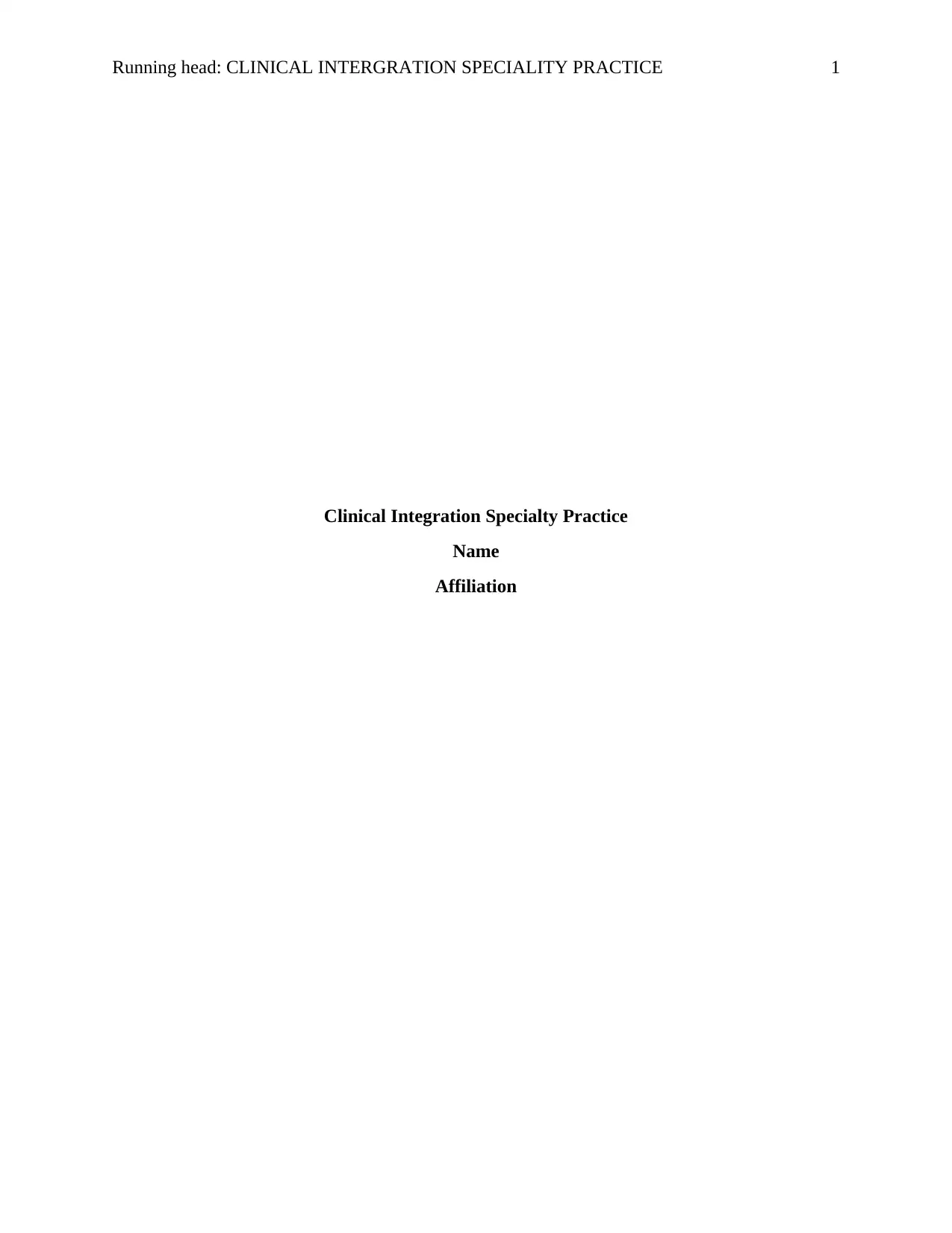
Running head: CLINICAL INTERGRATION SPECIALITY PRACTICE 1
Clinical Integration Specialty Practice
Name
Affiliation
Clinical Integration Specialty Practice
Name
Affiliation
Paraphrase This Document
Need a fresh take? Get an instant paraphrase of this document with our AI Paraphraser
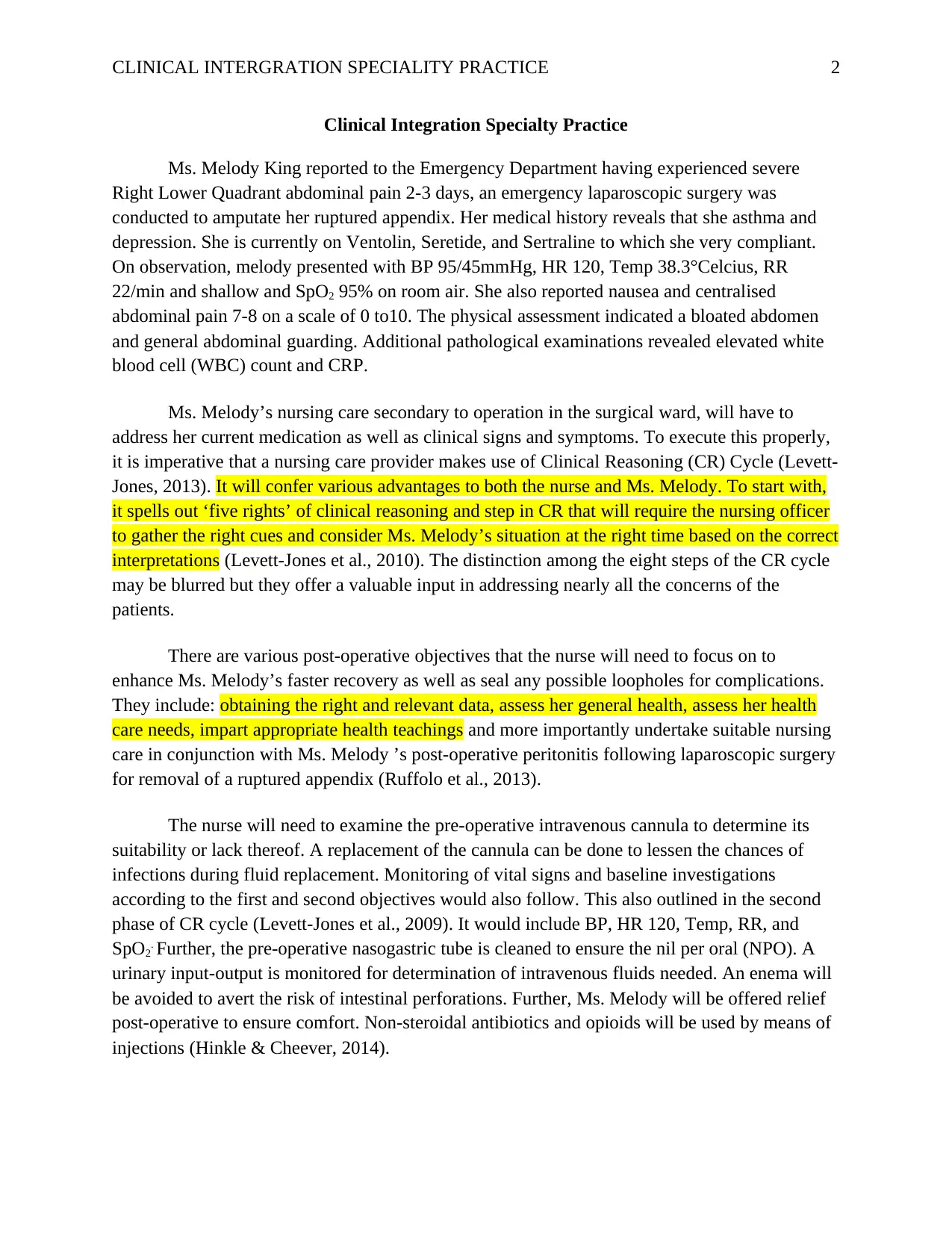
CLINICAL INTERGRATION SPECIALITY PRACTICE 2
Clinical Integration Specialty Practice
Ms. Melody King reported to the Emergency Department having experienced severe
Right Lower Quadrant abdominal pain 2-3 days, an emergency laparoscopic surgery was
conducted to amputate her ruptured appendix. Her medical history reveals that she asthma and
depression. She is currently on Ventolin, Seretide, and Sertraline to which she very compliant.
On observation, melody presented with BP 95/45mmHg, HR 120, Temp 38.3°Celcius, RR
22/min and shallow and SpO2 95% on room air. She also reported nausea and centralised
abdominal pain 7-8 on a scale of 0 to10. The physical assessment indicated a bloated abdomen
and general abdominal guarding. Additional pathological examinations revealed elevated white
blood cell (WBC) count and CRP.
Ms. Melody’s nursing care secondary to operation in the surgical ward, will have to
address her current medication as well as clinical signs and symptoms. To execute this properly,
it is imperative that a nursing care provider makes use of Clinical Reasoning (CR) Cycle (Levett-
Jones, 2013). It will confer various advantages to both the nurse and Ms. Melody. To start with,
it spells out ‘five rights’ of clinical reasoning and step in CR that will require the nursing officer
to gather the right cues and consider Ms. Melody’s situation at the right time based on the correct
interpretations (Levett-Jones et al., 2010). The distinction among the eight steps of the CR cycle
may be blurred but they offer a valuable input in addressing nearly all the concerns of the
patients.
There are various post-operative objectives that the nurse will need to focus on to
enhance Ms. Melody’s faster recovery as well as seal any possible loopholes for complications.
They include: obtaining the right and relevant data, assess her general health, assess her health
care needs, impart appropriate health teachings and more importantly undertake suitable nursing
care in conjunction with Ms. Melody ’s post-operative peritonitis following laparoscopic surgery
for removal of a ruptured appendix (Ruffolo et al., 2013).
The nurse will need to examine the pre-operative intravenous cannula to determine its
suitability or lack thereof. A replacement of the cannula can be done to lessen the chances of
infections during fluid replacement. Monitoring of vital signs and baseline investigations
according to the first and second objectives would also follow. This also outlined in the second
phase of CR cycle (Levett-Jones et al., 2009). It would include BP, HR 120, Temp, RR, and
SpO2. Further, the pre-operative nasogastric tube is cleaned to ensure the nil per oral (NPO). A
urinary input-output is monitored for determination of intravenous fluids needed. An enema will
be avoided to avert the risk of intestinal perforations. Further, Ms. Melody will be offered relief
post-operative to ensure comfort. Non-steroidal antibiotics and opioids will be used by means of
injections (Hinkle & Cheever, 2014).
Clinical Integration Specialty Practice
Ms. Melody King reported to the Emergency Department having experienced severe
Right Lower Quadrant abdominal pain 2-3 days, an emergency laparoscopic surgery was
conducted to amputate her ruptured appendix. Her medical history reveals that she asthma and
depression. She is currently on Ventolin, Seretide, and Sertraline to which she very compliant.
On observation, melody presented with BP 95/45mmHg, HR 120, Temp 38.3°Celcius, RR
22/min and shallow and SpO2 95% on room air. She also reported nausea and centralised
abdominal pain 7-8 on a scale of 0 to10. The physical assessment indicated a bloated abdomen
and general abdominal guarding. Additional pathological examinations revealed elevated white
blood cell (WBC) count and CRP.
Ms. Melody’s nursing care secondary to operation in the surgical ward, will have to
address her current medication as well as clinical signs and symptoms. To execute this properly,
it is imperative that a nursing care provider makes use of Clinical Reasoning (CR) Cycle (Levett-
Jones, 2013). It will confer various advantages to both the nurse and Ms. Melody. To start with,
it spells out ‘five rights’ of clinical reasoning and step in CR that will require the nursing officer
to gather the right cues and consider Ms. Melody’s situation at the right time based on the correct
interpretations (Levett-Jones et al., 2010). The distinction among the eight steps of the CR cycle
may be blurred but they offer a valuable input in addressing nearly all the concerns of the
patients.
There are various post-operative objectives that the nurse will need to focus on to
enhance Ms. Melody’s faster recovery as well as seal any possible loopholes for complications.
They include: obtaining the right and relevant data, assess her general health, assess her health
care needs, impart appropriate health teachings and more importantly undertake suitable nursing
care in conjunction with Ms. Melody ’s post-operative peritonitis following laparoscopic surgery
for removal of a ruptured appendix (Ruffolo et al., 2013).
The nurse will need to examine the pre-operative intravenous cannula to determine its
suitability or lack thereof. A replacement of the cannula can be done to lessen the chances of
infections during fluid replacement. Monitoring of vital signs and baseline investigations
according to the first and second objectives would also follow. This also outlined in the second
phase of CR cycle (Levett-Jones et al., 2009). It would include BP, HR 120, Temp, RR, and
SpO2. Further, the pre-operative nasogastric tube is cleaned to ensure the nil per oral (NPO). A
urinary input-output is monitored for determination of intravenous fluids needed. An enema will
be avoided to avert the risk of intestinal perforations. Further, Ms. Melody will be offered relief
post-operative to ensure comfort. Non-steroidal antibiotics and opioids will be used by means of
injections (Hinkle & Cheever, 2014).
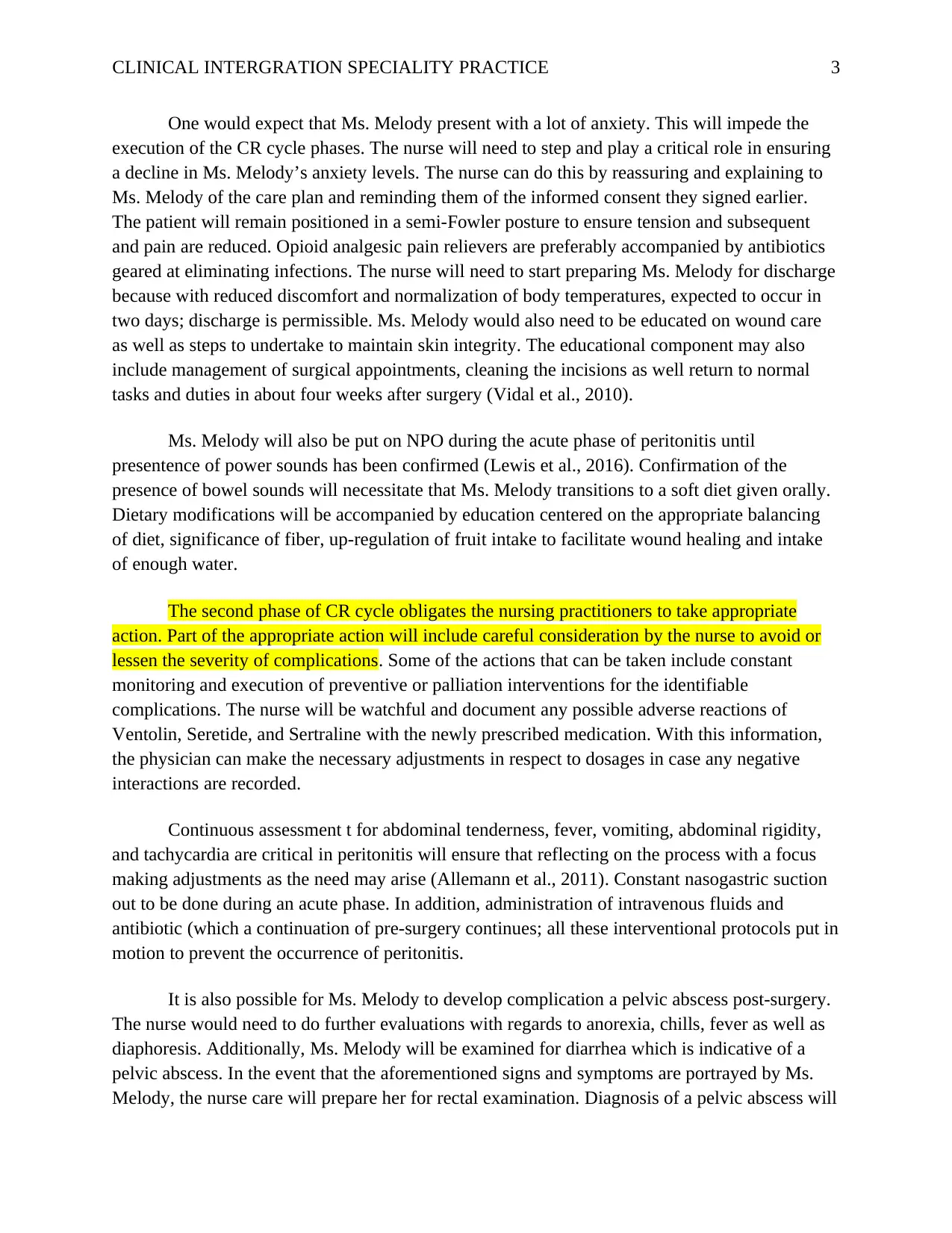
CLINICAL INTERGRATION SPECIALITY PRACTICE 3
One would expect that Ms. Melody present with a lot of anxiety. This will impede the
execution of the CR cycle phases. The nurse will need to step and play a critical role in ensuring
a decline in Ms. Melody’s anxiety levels. The nurse can do this by reassuring and explaining to
Ms. Melody of the care plan and reminding them of the informed consent they signed earlier.
The patient will remain positioned in a semi-Fowler posture to ensure tension and subsequent
and pain are reduced. Opioid analgesic pain relievers are preferably accompanied by antibiotics
geared at eliminating infections. The nurse will need to start preparing Ms. Melody for discharge
because with reduced discomfort and normalization of body temperatures, expected to occur in
two days; discharge is permissible. Ms. Melody would also need to be educated on wound care
as well as steps to undertake to maintain skin integrity. The educational component may also
include management of surgical appointments, cleaning the incisions as well return to normal
tasks and duties in about four weeks after surgery (Vidal et al., 2010).
Ms. Melody will also be put on NPO during the acute phase of peritonitis until
presentence of power sounds has been confirmed (Lewis et al., 2016). Confirmation of the
presence of bowel sounds will necessitate that Ms. Melody transitions to a soft diet given orally.
Dietary modifications will be accompanied by education centered on the appropriate balancing
of diet, significance of fiber, up-regulation of fruit intake to facilitate wound healing and intake
of enough water.
The second phase of CR cycle obligates the nursing practitioners to take appropriate
action. Part of the appropriate action will include careful consideration by the nurse to avoid or
lessen the severity of complications. Some of the actions that can be taken include constant
monitoring and execution of preventive or palliation interventions for the identifiable
complications. The nurse will be watchful and document any possible adverse reactions of
Ventolin, Seretide, and Sertraline with the newly prescribed medication. With this information,
the physician can make the necessary adjustments in respect to dosages in case any negative
interactions are recorded.
Continuous assessment t for abdominal tenderness, fever, vomiting, abdominal rigidity,
and tachycardia are critical in peritonitis will ensure that reflecting on the process with a focus
making adjustments as the need may arise (Allemann et al., 2011). Constant nasogastric suction
out to be done during an acute phase. In addition, administration of intravenous fluids and
antibiotic (which a continuation of pre-surgery continues; all these interventional protocols put in
motion to prevent the occurrence of peritonitis.
It is also possible for Ms. Melody to develop complication a pelvic abscess post-surgery.
The nurse would need to do further evaluations with regards to anorexia, chills, fever as well as
diaphoresis. Additionally, Ms. Melody will be examined for diarrhea which is indicative of a
pelvic abscess. In the event that the aforementioned signs and symptoms are portrayed by Ms.
Melody, the nurse care will prepare her for rectal examination. Diagnosis of a pelvic abscess will
One would expect that Ms. Melody present with a lot of anxiety. This will impede the
execution of the CR cycle phases. The nurse will need to step and play a critical role in ensuring
a decline in Ms. Melody’s anxiety levels. The nurse can do this by reassuring and explaining to
Ms. Melody of the care plan and reminding them of the informed consent they signed earlier.
The patient will remain positioned in a semi-Fowler posture to ensure tension and subsequent
and pain are reduced. Opioid analgesic pain relievers are preferably accompanied by antibiotics
geared at eliminating infections. The nurse will need to start preparing Ms. Melody for discharge
because with reduced discomfort and normalization of body temperatures, expected to occur in
two days; discharge is permissible. Ms. Melody would also need to be educated on wound care
as well as steps to undertake to maintain skin integrity. The educational component may also
include management of surgical appointments, cleaning the incisions as well return to normal
tasks and duties in about four weeks after surgery (Vidal et al., 2010).
Ms. Melody will also be put on NPO during the acute phase of peritonitis until
presentence of power sounds has been confirmed (Lewis et al., 2016). Confirmation of the
presence of bowel sounds will necessitate that Ms. Melody transitions to a soft diet given orally.
Dietary modifications will be accompanied by education centered on the appropriate balancing
of diet, significance of fiber, up-regulation of fruit intake to facilitate wound healing and intake
of enough water.
The second phase of CR cycle obligates the nursing practitioners to take appropriate
action. Part of the appropriate action will include careful consideration by the nurse to avoid or
lessen the severity of complications. Some of the actions that can be taken include constant
monitoring and execution of preventive or palliation interventions for the identifiable
complications. The nurse will be watchful and document any possible adverse reactions of
Ventolin, Seretide, and Sertraline with the newly prescribed medication. With this information,
the physician can make the necessary adjustments in respect to dosages in case any negative
interactions are recorded.
Continuous assessment t for abdominal tenderness, fever, vomiting, abdominal rigidity,
and tachycardia are critical in peritonitis will ensure that reflecting on the process with a focus
making adjustments as the need may arise (Allemann et al., 2011). Constant nasogastric suction
out to be done during an acute phase. In addition, administration of intravenous fluids and
antibiotic (which a continuation of pre-surgery continues; all these interventional protocols put in
motion to prevent the occurrence of peritonitis.
It is also possible for Ms. Melody to develop complication a pelvic abscess post-surgery.
The nurse would need to do further evaluations with regards to anorexia, chills, fever as well as
diaphoresis. Additionally, Ms. Melody will be examined for diarrhea which is indicative of a
pelvic abscess. In the event that the aforementioned signs and symptoms are portrayed by Ms.
Melody, the nurse care will prepare her for rectal examination. Diagnosis of a pelvic abscess will
⊘ This is a preview!⊘
Do you want full access?
Subscribe today to unlock all pages.

Trusted by 1+ million students worldwide
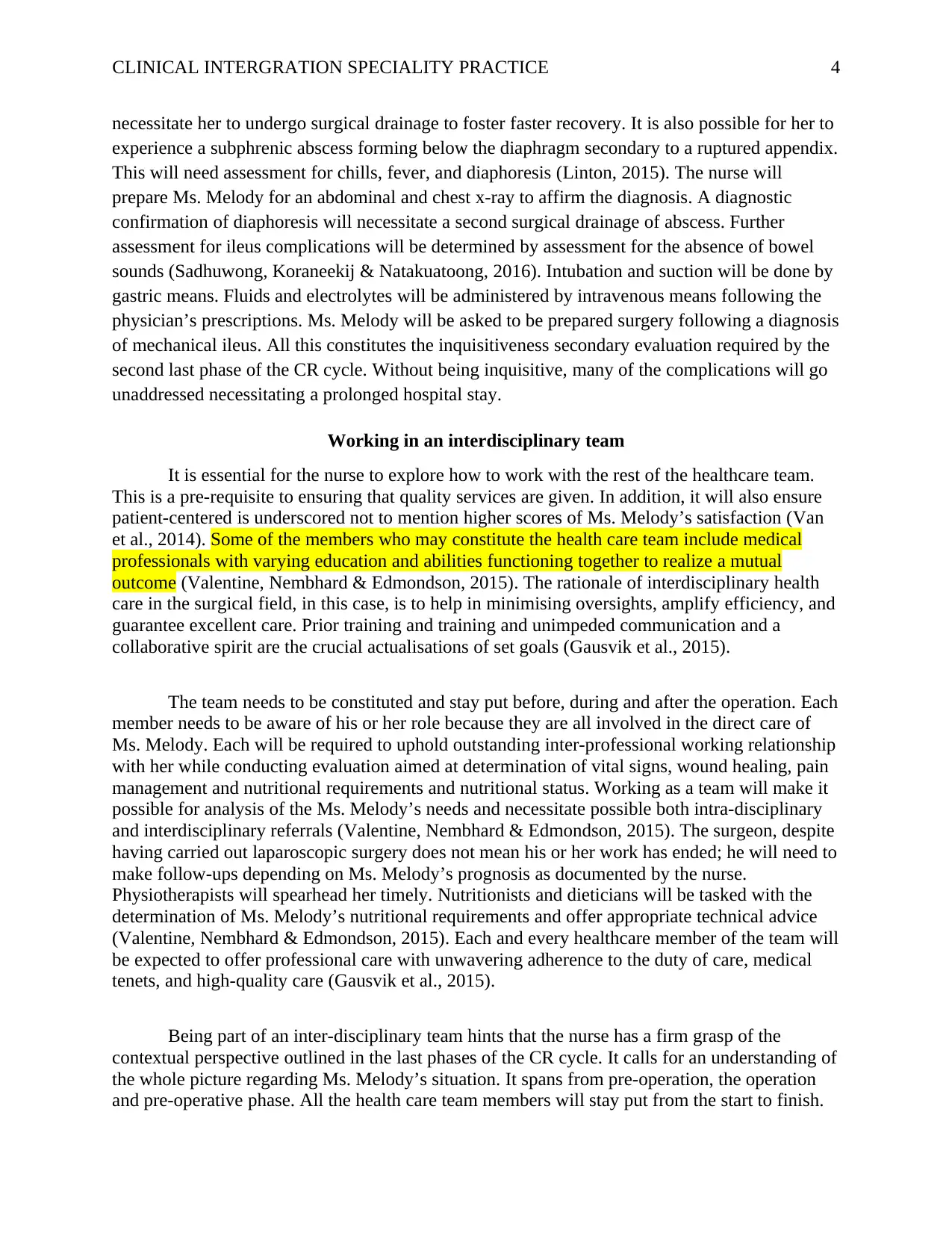
CLINICAL INTERGRATION SPECIALITY PRACTICE 4
necessitate her to undergo surgical drainage to foster faster recovery. It is also possible for her to
experience a subphrenic abscess forming below the diaphragm secondary to a ruptured appendix.
This will need assessment for chills, fever, and diaphoresis (Linton, 2015). The nurse will
prepare Ms. Melody for an abdominal and chest x-ray to affirm the diagnosis. A diagnostic
confirmation of diaphoresis will necessitate a second surgical drainage of abscess. Further
assessment for ileus complications will be determined by assessment for the absence of bowel
sounds (Sadhuwong, Koraneekij & Natakuatoong, 2016). Intubation and suction will be done by
gastric means. Fluids and electrolytes will be administered by intravenous means following the
physician’s prescriptions. Ms. Melody will be asked to be prepared surgery following a diagnosis
of mechanical ileus. All this constitutes the inquisitiveness secondary evaluation required by the
second last phase of the CR cycle. Without being inquisitive, many of the complications will go
unaddressed necessitating a prolonged hospital stay.
Working in an interdisciplinary team
It is essential for the nurse to explore how to work with the rest of the healthcare team.
This is a pre-requisite to ensuring that quality services are given. In addition, it will also ensure
patient-centered is underscored not to mention higher scores of Ms. Melody’s satisfaction (Van
et al., 2014). Some of the members who may constitute the health care team include medical
professionals with varying education and abilities functioning together to realize a mutual
outcome (Valentine, Nembhard & Edmondson, 2015). The rationale of interdisciplinary health
care in the surgical field, in this case, is to help in minimising oversights, amplify efficiency, and
guarantee excellent care. Prior training and training and unimpeded communication and a
collaborative spirit are the crucial actualisations of set goals (Gausvik et al., 2015).
The team needs to be constituted and stay put before, during and after the operation. Each
member needs to be aware of his or her role because they are all involved in the direct care of
Ms. Melody. Each will be required to uphold outstanding inter-professional working relationship
with her while conducting evaluation aimed at determination of vital signs, wound healing, pain
management and nutritional requirements and nutritional status. Working as a team will make it
possible for analysis of the Ms. Melody’s needs and necessitate possible both intra-disciplinary
and interdisciplinary referrals (Valentine, Nembhard & Edmondson, 2015). The surgeon, despite
having carried out laparoscopic surgery does not mean his or her work has ended; he will need to
make follow-ups depending on Ms. Melody’s prognosis as documented by the nurse.
Physiotherapists will spearhead her timely. Nutritionists and dieticians will be tasked with the
determination of Ms. Melody’s nutritional requirements and offer appropriate technical advice
(Valentine, Nembhard & Edmondson, 2015). Each and every healthcare member of the team will
be expected to offer professional care with unwavering adherence to the duty of care, medical
tenets, and high-quality care (Gausvik et al., 2015).
Being part of an inter-disciplinary team hints that the nurse has a firm grasp of the
contextual perspective outlined in the last phases of the CR cycle. It calls for an understanding of
the whole picture regarding Ms. Melody’s situation. It spans from pre-operation, the operation
and pre-operative phase. All the health care team members will stay put from the start to finish.
necessitate her to undergo surgical drainage to foster faster recovery. It is also possible for her to
experience a subphrenic abscess forming below the diaphragm secondary to a ruptured appendix.
This will need assessment for chills, fever, and diaphoresis (Linton, 2015). The nurse will
prepare Ms. Melody for an abdominal and chest x-ray to affirm the diagnosis. A diagnostic
confirmation of diaphoresis will necessitate a second surgical drainage of abscess. Further
assessment for ileus complications will be determined by assessment for the absence of bowel
sounds (Sadhuwong, Koraneekij & Natakuatoong, 2016). Intubation and suction will be done by
gastric means. Fluids and electrolytes will be administered by intravenous means following the
physician’s prescriptions. Ms. Melody will be asked to be prepared surgery following a diagnosis
of mechanical ileus. All this constitutes the inquisitiveness secondary evaluation required by the
second last phase of the CR cycle. Without being inquisitive, many of the complications will go
unaddressed necessitating a prolonged hospital stay.
Working in an interdisciplinary team
It is essential for the nurse to explore how to work with the rest of the healthcare team.
This is a pre-requisite to ensuring that quality services are given. In addition, it will also ensure
patient-centered is underscored not to mention higher scores of Ms. Melody’s satisfaction (Van
et al., 2014). Some of the members who may constitute the health care team include medical
professionals with varying education and abilities functioning together to realize a mutual
outcome (Valentine, Nembhard & Edmondson, 2015). The rationale of interdisciplinary health
care in the surgical field, in this case, is to help in minimising oversights, amplify efficiency, and
guarantee excellent care. Prior training and training and unimpeded communication and a
collaborative spirit are the crucial actualisations of set goals (Gausvik et al., 2015).
The team needs to be constituted and stay put before, during and after the operation. Each
member needs to be aware of his or her role because they are all involved in the direct care of
Ms. Melody. Each will be required to uphold outstanding inter-professional working relationship
with her while conducting evaluation aimed at determination of vital signs, wound healing, pain
management and nutritional requirements and nutritional status. Working as a team will make it
possible for analysis of the Ms. Melody’s needs and necessitate possible both intra-disciplinary
and interdisciplinary referrals (Valentine, Nembhard & Edmondson, 2015). The surgeon, despite
having carried out laparoscopic surgery does not mean his or her work has ended; he will need to
make follow-ups depending on Ms. Melody’s prognosis as documented by the nurse.
Physiotherapists will spearhead her timely. Nutritionists and dieticians will be tasked with the
determination of Ms. Melody’s nutritional requirements and offer appropriate technical advice
(Valentine, Nembhard & Edmondson, 2015). Each and every healthcare member of the team will
be expected to offer professional care with unwavering adherence to the duty of care, medical
tenets, and high-quality care (Gausvik et al., 2015).
Being part of an inter-disciplinary team hints that the nurse has a firm grasp of the
contextual perspective outlined in the last phases of the CR cycle. It calls for an understanding of
the whole picture regarding Ms. Melody’s situation. It spans from pre-operation, the operation
and pre-operative phase. All the health care team members will stay put from the start to finish.
Paraphrase This Document
Need a fresh take? Get an instant paraphrase of this document with our AI Paraphraser
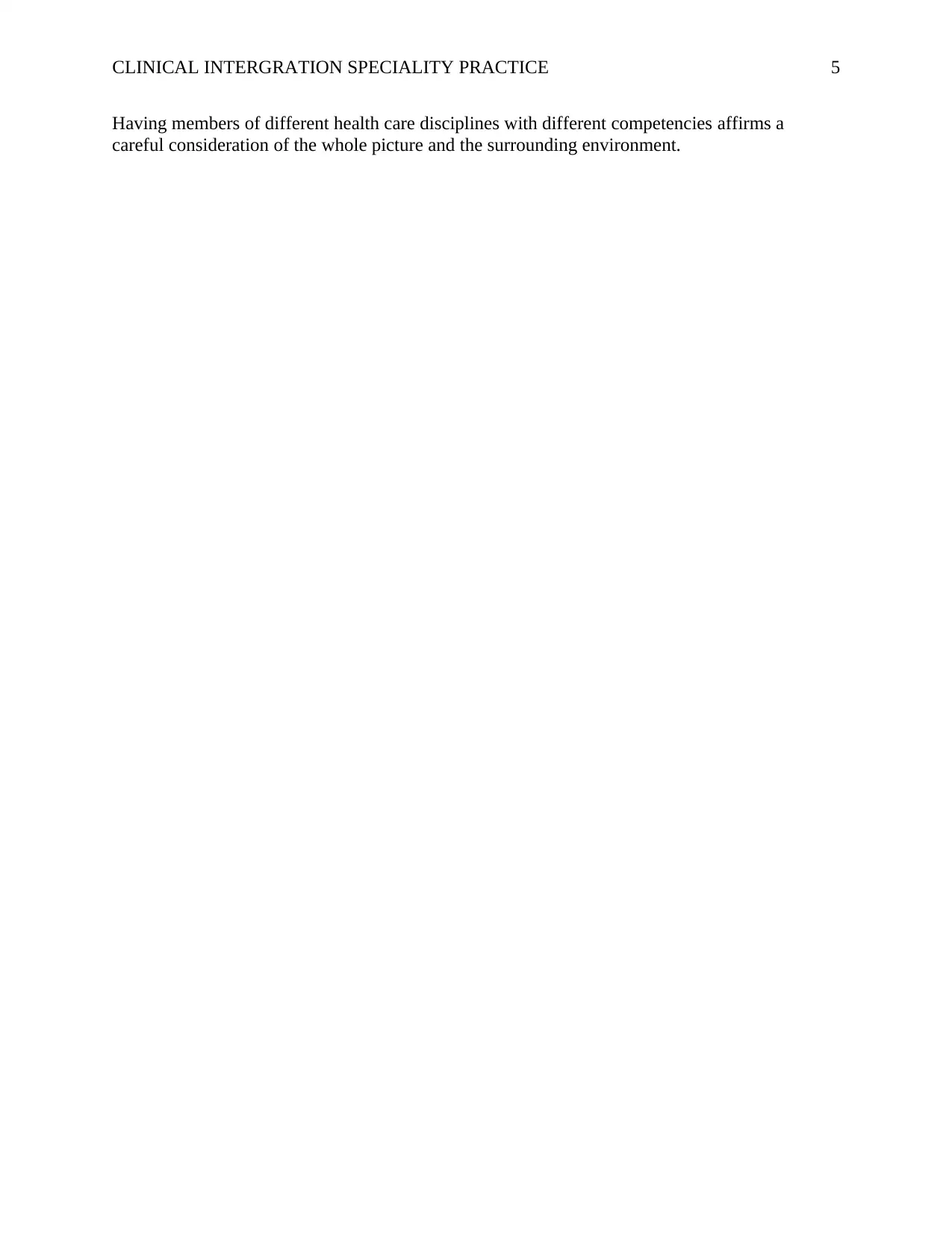
CLINICAL INTERGRATION SPECIALITY PRACTICE 5
Having members of different health care disciplines with different competencies affirms a
careful consideration of the whole picture and the surrounding environment.
Having members of different health care disciplines with different competencies affirms a
careful consideration of the whole picture and the surrounding environment.
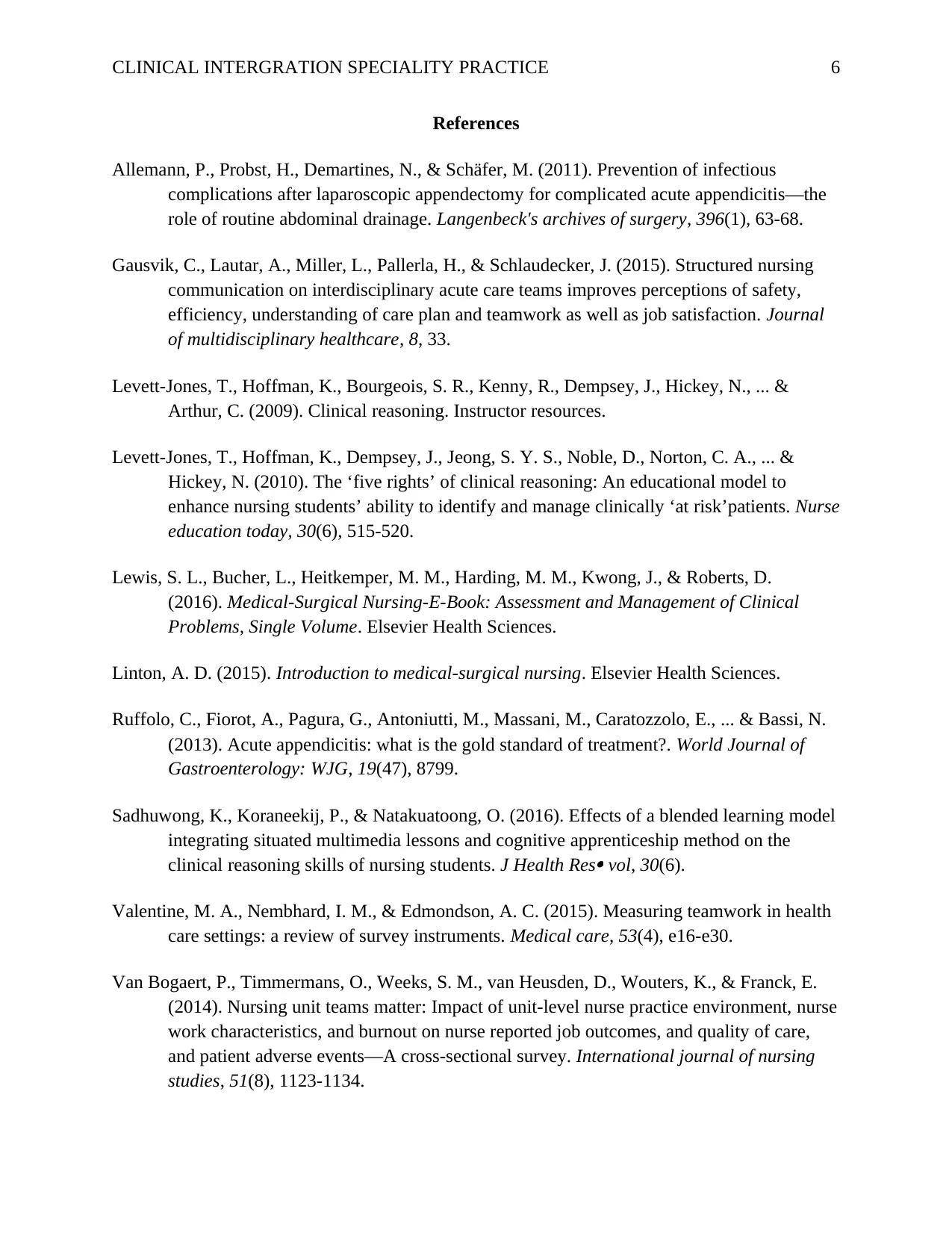
CLINICAL INTERGRATION SPECIALITY PRACTICE 6
References
Allemann, P., Probst, H., Demartines, N., & Schäfer, M. (2011). Prevention of infectious
complications after laparoscopic appendectomy for complicated acute appendicitis—the
role of routine abdominal drainage. Langenbeck's archives of surgery, 396(1), 63-68.
Gausvik, C., Lautar, A., Miller, L., Pallerla, H., & Schlaudecker, J. (2015). Structured nursing
communication on interdisciplinary acute care teams improves perceptions of safety,
efficiency, understanding of care plan and teamwork as well as job satisfaction. Journal
of multidisciplinary healthcare, 8, 33.
Levett-Jones, T., Hoffman, K., Bourgeois, S. R., Kenny, R., Dempsey, J., Hickey, N., ... &
Arthur, C. (2009). Clinical reasoning. Instructor resources.
Levett-Jones, T., Hoffman, K., Dempsey, J., Jeong, S. Y. S., Noble, D., Norton, C. A., ... &
Hickey, N. (2010). The ‘five rights’ of clinical reasoning: An educational model to
enhance nursing students’ ability to identify and manage clinically ‘at risk’patients. Nurse
education today, 30(6), 515-520.
Lewis, S. L., Bucher, L., Heitkemper, M. M., Harding, M. M., Kwong, J., & Roberts, D.
(2016). Medical-Surgical Nursing-E-Book: Assessment and Management of Clinical
Problems, Single Volume. Elsevier Health Sciences.
Linton, A. D. (2015). Introduction to medical-surgical nursing. Elsevier Health Sciences.
Ruffolo, C., Fiorot, A., Pagura, G., Antoniutti, M., Massani, M., Caratozzolo, E., ... & Bassi, N.
(2013). Acute appendicitis: what is the gold standard of treatment?. World Journal of
Gastroenterology: WJG, 19(47), 8799.
Sadhuwong, K., Koraneekij, P., & Natakuatoong, O. (2016). Effects of a blended learning model
integrating situated multimedia lessons and cognitive apprenticeship method on the
clinical reasoning skills of nursing students. J Health Res
vol, 30(6).
Valentine, M. A., Nembhard, I. M., & Edmondson, A. C. (2015). Measuring teamwork in health
care settings: a review of survey instruments. Medical care, 53(4), e16-e30.
Van Bogaert, P., Timmermans, O., Weeks, S. M., van Heusden, D., Wouters, K., & Franck, E.
(2014). Nursing unit teams matter: Impact of unit-level nurse practice environment, nurse
work characteristics, and burnout on nurse reported job outcomes, and quality of care,
and patient adverse events—A cross-sectional survey. International journal of nursing
studies, 51(8), 1123-1134.
References
Allemann, P., Probst, H., Demartines, N., & Schäfer, M. (2011). Prevention of infectious
complications after laparoscopic appendectomy for complicated acute appendicitis—the
role of routine abdominal drainage. Langenbeck's archives of surgery, 396(1), 63-68.
Gausvik, C., Lautar, A., Miller, L., Pallerla, H., & Schlaudecker, J. (2015). Structured nursing
communication on interdisciplinary acute care teams improves perceptions of safety,
efficiency, understanding of care plan and teamwork as well as job satisfaction. Journal
of multidisciplinary healthcare, 8, 33.
Levett-Jones, T., Hoffman, K., Bourgeois, S. R., Kenny, R., Dempsey, J., Hickey, N., ... &
Arthur, C. (2009). Clinical reasoning. Instructor resources.
Levett-Jones, T., Hoffman, K., Dempsey, J., Jeong, S. Y. S., Noble, D., Norton, C. A., ... &
Hickey, N. (2010). The ‘five rights’ of clinical reasoning: An educational model to
enhance nursing students’ ability to identify and manage clinically ‘at risk’patients. Nurse
education today, 30(6), 515-520.
Lewis, S. L., Bucher, L., Heitkemper, M. M., Harding, M. M., Kwong, J., & Roberts, D.
(2016). Medical-Surgical Nursing-E-Book: Assessment and Management of Clinical
Problems, Single Volume. Elsevier Health Sciences.
Linton, A. D. (2015). Introduction to medical-surgical nursing. Elsevier Health Sciences.
Ruffolo, C., Fiorot, A., Pagura, G., Antoniutti, M., Massani, M., Caratozzolo, E., ... & Bassi, N.
(2013). Acute appendicitis: what is the gold standard of treatment?. World Journal of
Gastroenterology: WJG, 19(47), 8799.
Sadhuwong, K., Koraneekij, P., & Natakuatoong, O. (2016). Effects of a blended learning model
integrating situated multimedia lessons and cognitive apprenticeship method on the
clinical reasoning skills of nursing students. J Health Res
vol, 30(6).
Valentine, M. A., Nembhard, I. M., & Edmondson, A. C. (2015). Measuring teamwork in health
care settings: a review of survey instruments. Medical care, 53(4), e16-e30.
Van Bogaert, P., Timmermans, O., Weeks, S. M., van Heusden, D., Wouters, K., & Franck, E.
(2014). Nursing unit teams matter: Impact of unit-level nurse practice environment, nurse
work characteristics, and burnout on nurse reported job outcomes, and quality of care,
and patient adverse events—A cross-sectional survey. International journal of nursing
studies, 51(8), 1123-1134.
⊘ This is a preview!⊘
Do you want full access?
Subscribe today to unlock all pages.

Trusted by 1+ million students worldwide
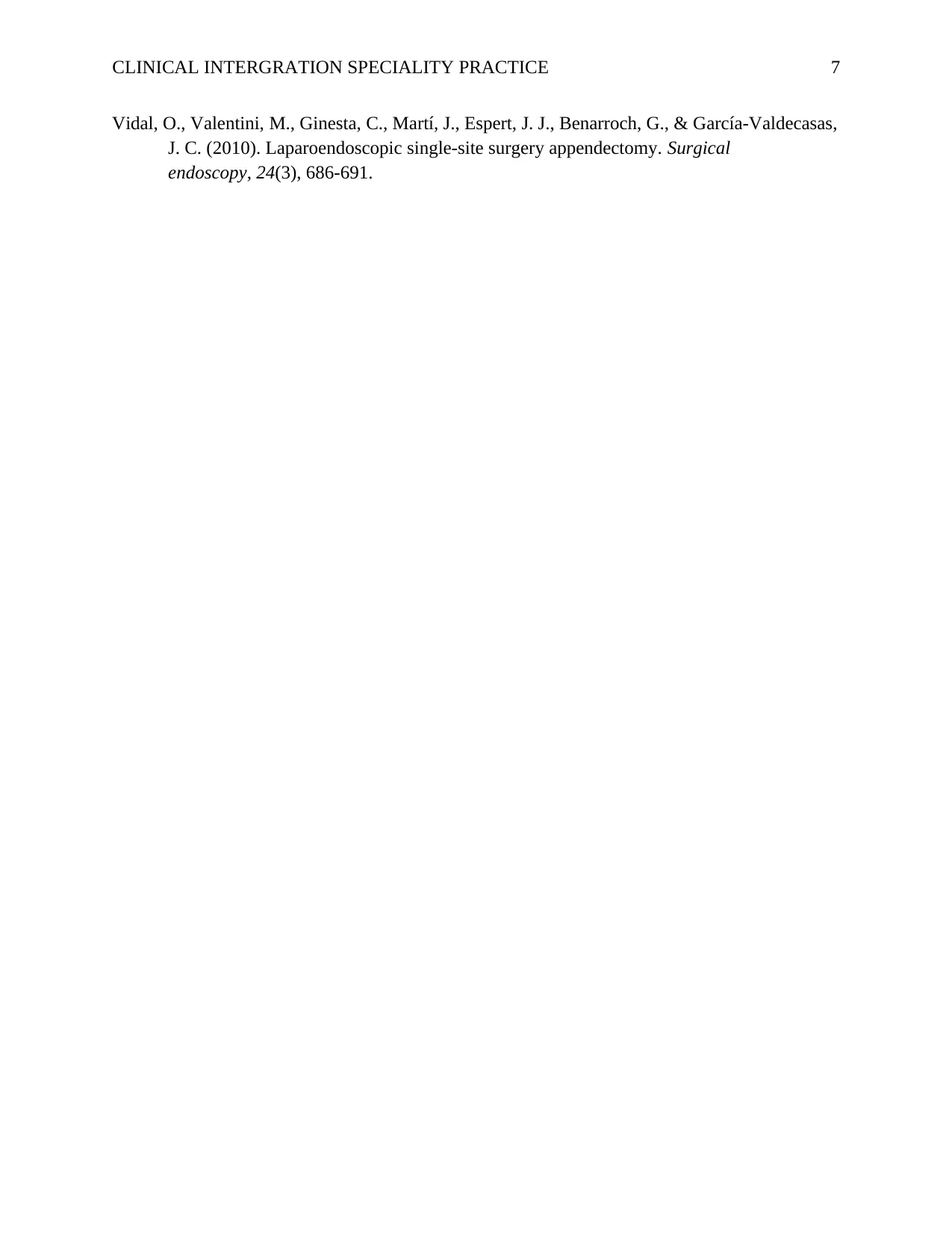
CLINICAL INTERGRATION SPECIALITY PRACTICE 7
Vidal, O., Valentini, M., Ginesta, C., Martí, J., Espert, J. J., Benarroch, G., & García-Valdecasas,
J. C. (2010). Laparoendoscopic single-site surgery appendectomy. Surgical
endoscopy, 24(3), 686-691.
Vidal, O., Valentini, M., Ginesta, C., Martí, J., Espert, J. J., Benarroch, G., & García-Valdecasas,
J. C. (2010). Laparoendoscopic single-site surgery appendectomy. Surgical
endoscopy, 24(3), 686-691.
1 out of 7
Related Documents
Your All-in-One AI-Powered Toolkit for Academic Success.
+13062052269
info@desklib.com
Available 24*7 on WhatsApp / Email
![[object Object]](/_next/static/media/star-bottom.7253800d.svg)
Unlock your academic potential
Copyright © 2020–2025 A2Z Services. All Rights Reserved. Developed and managed by ZUCOL.





